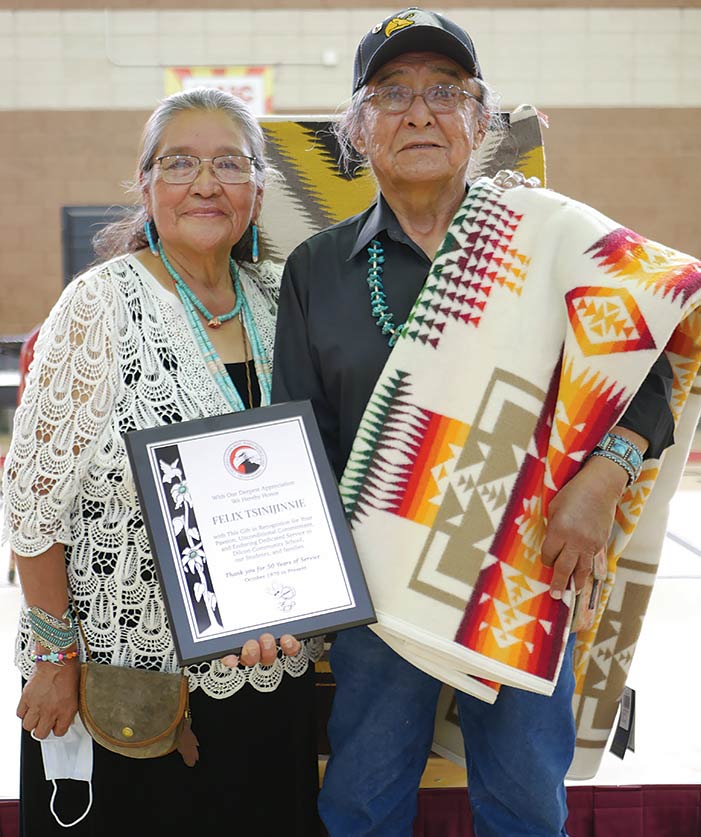
‘There for the kids’: Bus driver honored for 51 years of service
WINDOW ROCK
Bus driver and Dilkon Chapter Vice President Felix Tsinijinnie was recently honored by Dilcon Community School for his 51 straight years of dedicated service to students and families.

Submitted
Felix Tsinijinnie and his wife, Joanne Tsinijinnie, with his appreciation plaque at the Nov. 2 recognition ceremony in the Dilcon Community School gymnasium.
The school is a tribally run elementary school that serves grades K-8.
“Our philosophy is children learn best when people care,” said Tsinijinnie, who is fluent in Navajo and English. “That’s what makes me feel really good about working here.
“I feel like I am there for the kids,” he said. “I really do care about what goes on in their education.”
Tsinijinnie’s supervisor, Transportation Manager Margaret Lee, said she wouldn’t hesitate to give him an A plus for his dedication to his job, communication skills and ability to work collaboratively with the community, parents, students and staff.
“He’s got the greatest strength of all,” said Lee, who has worked with Tsinijinnie for 19 years. “He’s the eldest of all too, so we look up to him.
“He’s always got some good teachings,” she said. “He’s a mentor for many of our staff here.”
Lee described Tsinijinnie as very open, honest and passionate about his work.
“He gets down to the children’s level,” said Lee. “Whatever he has to give to enlighten a child, he’s just right there beside them.”
Navajo Language and Culture teacher Arlene Tsosie said Tsinijinnie is a great resource for information, including about the history of the school and the Dilkon community.
“He’s a very outgoing person,” said Tsosie. “He likes to tell stories and share his knowledge.”
In turn, Tsosie said the kids address Tsinijinnie as “Grandpa” or “Cheii.”
Tsinijinnie is Ashiihi, born for Todich’ii’nii. His naalii is Tsi’naajinii and cheii is Kinyaa’aanii.
‘Energizer Bunny’
In 1970, Tsinijinnie started working at Dilcon school as a teacher’s assistant and then became a home living assistant and dorm manager in the residential halls.
Tsinijinnie credit’s former principal Donovan Heath for first inspiring him to help students build better futures.
“He was a real nice person, a man that had a heart for students, families,” said Tsinijinnie. “He was very involved with the community.”
In 1987, Tsinijinnie got his chauffeur’s license so he could drive transportation vehicles for the school and in 1991 became a full-time bus driver, the job he holds to this day.
“We are responsible for the kids that we transport, every morning, every day,” he said. “When I’m driving, that’s what I’m thinking. I have to pay attention to what I’m doing on the road. There’s a lot of scary drivers out there.”
Many students live miles off of the highway on dirt roads, he said.
“It takes time driving on rough roads,” he said. “Sometimes it’s muddy. Sometimes it’s raining or snowing.
Despite the challenging road condition, Tsinijinnie is proud to say in his 30 years of driving buses, he’s never had any serious accidents.
As part of his routine, Tsinijiniie takes up every day at 2:30 a.m. to start his workday at the school by 5 a.m.
“I like doing what I’m doing,” he said. “I get up early. I don’t need no alarm clock like I used to.”
Lee said Tsinijinnie is very determined and punctual.
“He’s always the first one here at work,” she chuckled. “He beats all of us here in the morning.”
Since bus drivers work split shifts to accommodate the morning and afternoon student transports, their days are long and filled with multiple duties, including pre and post-trip inspections and reports.
“You’re the first person out there early in the morning,” he said. “When you get there, you have to check the bus all the way from the wheels to the engine, the oil.”
Tsinijinnie works Monday through Friday, but often works weekends too if there are sports events, field trips or pandemic tutoring that require transportation for the kids.
School CEO and Principal Bill Wachunas said school-bus drivers are especially important because they’re the first staff students see in the morning and the last one’s they see at the end of the day.
“This gentleman is just like the Energizer Bunny – he just keeps going and going, and he’s very dedicated to his work,” said Wachunas. “He’s always wanting to help out and he’s always available.”
Tsinijinnie said these days there are many bus-driver positions unfilled partially because people are shy of taking on the responsibilities of the job.
“Bus drivers are scarce these days,” he said.
In the past year and a half, the COVID-19 pandemic has added even more duties to the bus-driver’s task list. With the aid of bus monitors, buses are sanitized after each trip and students adhere to COVID-19 safety protocols.
“They take their temperatures, make sure they have hand sanitizers and that they’re six feet apart,” said Tsinijinnie. “We stagger the kids on the buses and we can only carry about 15 kids. That’s how we take care of ourselves, the monitors and the students.”
Prior to the pandemic, the buses were filled to capacity of 66 students, he said, but now many of the kids are doing virtual education.
“We have to bring breakfast and lunch to them and pick up their lessons,” he said.
‘Living history’
Needless to say, over five decades, Tsinijinnie says he’s seen many things change in his community and in the education system.
When he was growing up in Standing Horse, there were only dirt roads in the area and children were taken to school by their parents on horseback or in a wagon.
“That’s how I went to school,” he said. “And it was dirt road all the way from Second Mesa (Hopi) to Winslow. Only certain people had vehicles, the ones who were employed on Navajo and had an income.”
Back then, many families lived in deeply rural areas in shelters made out of cedar trees, he said.
Food was cooked over a fire, water came from rain, snow and flowing streams, and families relied on hunting for food.
“That’s how they survived at that time,” he said. “People would help each other. It’s still like that, but different now. Everybody goes about their own business. That’s how it is these days because they have vehicles and their own homes.”
When Tsinijinnie was a youngster, the only education buildings were a couple of small BIA trailers, he said.
Now the new Dilcon school, built in the shape of a child standing, is a state-of-the-art campus designed in line with the Diné planning model, the four directions, the sacred mountains and the life cycle of corn.
“The school was rebuilt traditional,” said Tsinijinnie. “There’s teachings. That’s how the kids are growing. That’s how these kids are being taught. It’s a real good setting.”
Tsinijinnie said he’s witnessed generations of students go on to become outstanding citizens.
“They are doctors, nurses, CHRs, construction workers, truck drivers, making a real good living and building a future,” he said.
Many of his former students have been working as essential workers during the pandemic, delivering food and water, he said with pride.
“They’re helping each other and families, the community,” said Tsinijinnie. “That’s how I wanted the students to be. That’s how I wanted them to be when they go out in life.”
However, Tsinijinnie said many young students today face unprecedented challenges in our fast-paced society.
“Like staying away from drugs and all the things that can hinder them from doing what they want,” he said. “It’s a different world for them. Everything’s right there in their hands. What they want is right there.”
Wachunas said Tninijinnie is firm and fair with students and enjoys sharing stories from the past.
“He’s very traditional,” said Wachunas. “He’s like living history because he knows so much about the school. He’s a treasure for the school, for sure.”
Tsinijinnie said he was grateful to the school, students, teachers and board members who honored his half century of employment with the school.
“They recognized me and gave me some gifts,” he said humbly. “I told the students to thank their Mom and Dad for enrolling them at the school.”
Tsinijinnie said after all, it’s the students who bring in the funding for the school, the facilities and to hire the employees.
“That’s what I always tell my students on the bus,” he said. “I tell them I appreciate them and that’s how I make a living.”








 Highway 264,
Highway 264, I-40, WB @ Winslow
I-40, WB @ Winslow